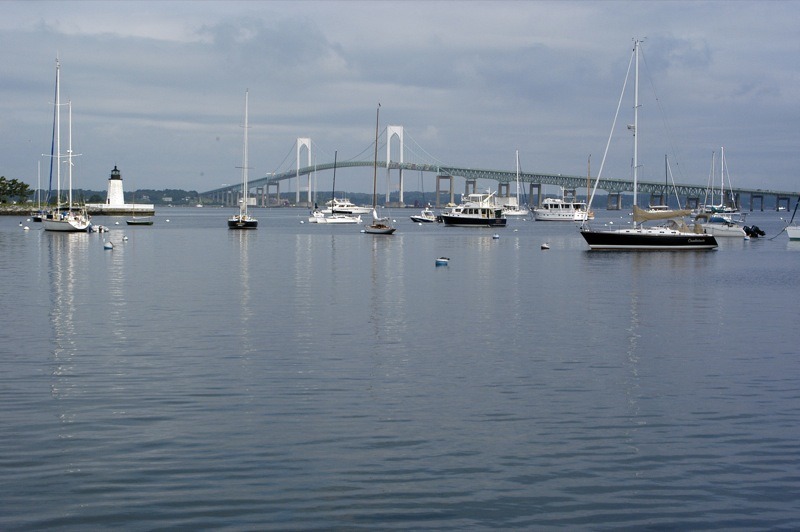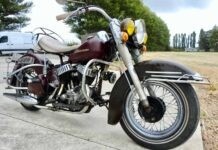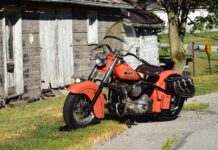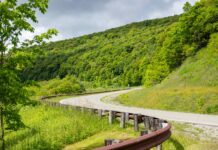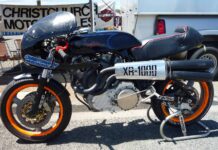
Motorcycling to mansions
It’s only 48 miles north to south and 37 miles east to west, but the smallest state in the U.S. has a history that is more voluminous than that of Texas and Alaska combined. Roger Williams founded Providence Plantations and established the first working democracy in 1636 after being banished from the Puritan colony of Plymouth for his “extreme” religious views. As a goldsmith I had traveled to the jewelry manufacturing centers of Warwick and Providence numerous times, but this would be my first visit to Newport.
My first stop is only a mile-and-a-half south of the Massachusetts border in Slaterville, the factory mill town created by John and Samuel Slater in 1803-1807. By memorizing the secrets of English cotton mills and immigrating to Rhode Island, Samuel created the first successful industrial weaving factory in the United States. The original mill was located in Pawtucket in 1793 (Slater Mill Historic Site) and it herald in the American Industrial Revolution. Slater quickly expanded upon his success by building another cotton mill and company village in on the Branch River in North Smithfield. This was America’s first planned industrial village, a town that remained completely owned by the Slater family until 1900 and where the concept of “the company store” originated. The original mill burned and was replaced in 1826 by one constructed of stone, but to my disappointment it has been transformed into condominiums.

Although the population of this state is just 1,051,000 residents, only Washington, D.C., and New Jersey have a higher population density. This, however, is where statistics become misleading. Potatoes, sweet corn, eggs, dairy products, honey, apples, greenhouse vegetables and ornamental plants are important agricultural businesses in this state and I can assure you that most of these don’t come from city garden plots. I figured that I could find country roads that would bring me almost to the city limits of Newport.
Cruising south I become a bit frustrated by posted speed limits that seem unrelated to rural settlements, road conditions or traffic density in western Rhode Island. Then again, the big cities are just a few miles away and almost every numbered highway that intersects Route 102 goes to these metropolitan areas.
Newport is situated on Aquidneck Island. When the second colony settled here in 1638 they began referring to it as the Rhode Island Colony to differentiate it from Roger William’s Providence Plantations—in fact, the official name for this state remains Rhode Island and Providence Plantations.
I like big bridges and the one between Jamestown Island and Newport is just such a structure. The $4 toll allows me the privilege of riding on the 11,248-foot long Claiborne-Pell Bridge, which spans the Eastern Passage of Narragansett Bay.
There’s a wide range of lodging in this city, but I simply take the advice of the Newport Visitor Center and stay at the Best Western Mainstay Inn, directly across from Newport Grand Slots Casino on Route 138. Clean, comfortable, and conveniently located it certainly meets my needs—I can even see my parked bike from the window. From here it’s a quick and easy ride to the historic downtown center.
I had two rather natural objectives that I wanted to locate in Newport: motorcycle parking and public restrooms. I’m writing a book entitled

Motorcycle Journeys through New England, and although these two things are not generally mentioned in most guidebooks or on websites, they should be. I already knew that the Newport County Visitors Center on America’s Cup Avenue had public restrooms and offered 30 minutes of free parking in the adjoining public parking garage (validation required), but surprise! The sign on the entry gate clearly states “No Motorcycles.” Ignoring the sign, I swerve around the barrier, and head over to discuss this with the parking attendants. It seems that if your motorcycle is heavy enough to activate the barrier gate the signs don’t apply to you. Perhaps I’m the only visitor to this city who doesn’t know this.
Investigating further, I discover that motorcycle parking can be found at the Seamen’s Church Institute at Bowen’s Landing and the odd-shaped spaces at the end of metered parking along Thames St.—parallel to America’s Cup Avenue—are reserved for motorcycles, free of charge, and have no time limit. Public restrooms can found at Ann St. Pier in the Antiques Armory Marketplace, Bowen’s Wharf, the Harbormaster building and Gateway Center. My primary mission has now been accomplished.
Having done a bit of research I’m aware that Newport hosted the first U.S. National Men’s Tennis Championship (1881), the National Lawn Tennis Championship (1899) and the U.S. Open Golf Championship (1895). Polo was introduced to the U.S. in Newport in 1876. The first U.S. circus was held in here in 1774 and the first U.S. jazz festival in 1954. I knew about the Newport Folk Festival and the America’s Cup races that made this city synonymous with yachting. Having hosted the first auto show in 1899 you’d naturally assume this was a motor-friendly city, but the first jail sentence for speeding in a car was handed down in Newport in 1904. The offender was driving 15 mph and since the posted speed limit hasn’t increased much during the last hundred years, I’m being careful.
After parking the bike in a motorcycles-only space across from Bowen’s Wharf, I set out to explore the downtown harbor from the Newport Shipyard to St. Anne’s Pier. The harbor is filled with everything from kayaks to mega-yachts and the public pier along the Goat Island Causeway is the place to see some astounding sailing vessels.
There are reputed to be more restored colonial buildings in Newport than any other city in the United States. The White Horse Tavern (c.1673) is the oldest tavern in America and a number of homes date to the late 1670s. The Great Friends Meeting House (c. 1699), Trinity Episcopal Church (c.1726) and Touro Synagogue (c.1759) are other historic structures, but the past and the present somehow seem to naturally co-exist here.

The most enigmatic building is the Newport Tower in Touro Park. The first governor of Rhode Island, Benedict Arnold, noted the stone tower in his will of 1677, but its construction is Medieval-styled Norse, has numerous proven astronomical alignment points and bears no known colonial American use despite being erroneously called the Touro Mill. Excavations have discovered only colonial artifacts and dating the mortar places its construction (or repair) between 1500 and 1630. Controversy raged even before Henry Wadsworth Longfellow and Oliver Wendell Holmes promoted the pro-Norse theory in the mid-19th century.
No trip to Newport is complete without visiting at least a couple of its Gilded Age mansions. My first stop is at The Elms, a lavish 18th-century French chateau design. It quickly becomes obvious that $1.4 million purchased quite a bit more in 1901 than is possible today. Next is The Breakers, the famous Vanderbilt summer “cottage” designed by Richard Morris Hunt in 1893. With 70 rooms, this Italian-Renaissance-style palazzo would be impossible to replicate in our modern era.
There are other mansions—private ones. They are large structures situated behind 20-foot high steel gates and screened by manicured forests and

shrubbery. I stop to photograph horses grazing in one pasture while sheep and llamas roam across another field. Farm-like estates within a city that has some of the most expensive residential real estate in the country comes as a complete surprise. I’m having a wonderful time slowly cruising along Ocean Drive and end up at Fort Adams, the largest coastal fortification in the U.S. Naturally it has great scenic views of the Narragansett Bay and Newport Harbor.
A single day is insufficient to take in what this city offers, but I can’t stay longer. Perhaps next year I’ll come and stay for a week, but tomorrow I must continue my motorcycle journeys through New England.


